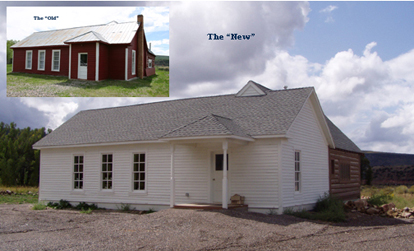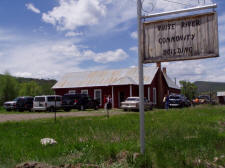

Historic Buford School House
Annual White River Community AssociationBuy-Fly Fishing TournamentThe fishing tournament supplies the fish for the annual Community Fish Fry held the 2nd Saturday of June. All Whitefish caught will be signed over on a donation sheet to the White River Community Association Held the 2nd weekend in March every year in Meeker Colorado We will be holding the tournament in 2024 with the new DOW limits on Whitefish. Alll Whitefish will be signed over as a donation to the Community Association.
Saturday - 8:00 am - 3:30 pm Sunday - 7:00 am – 1:00 pm Entry form and the entry fee of $500 can be completed and paid the first day of the tournament. Download & print the Tournament Rules (Word) Download & Print the Entry Form (Word) Tournament dates for 2024: March 9th and 10th Breakfast items and a sack lunch provided to participants on Saturday. Chili dinner for participants and their families on Sunday with awarding of top prizes. Limited to 12 teams fishing for Whitefish on the White River Entry fee: $500 per team (4-person teams)(cash or check only) Call Secretary/Treasurer Callie Scritchfield at 970-250-6825 or President Betsie Thompson at 970-878-0955 for availability. Come enjoy the weekend in Meeker and the White River Valley. This map will show you how to get to the Buford School House and White River Community Association.
The one-room Buford School, 174-566 New Castle Buford Rd, Meeker, CO 81641, was built in 1902 and served local students for fifty years. After the building stopped being used as a school in 1952, it was renovated and converted into a community center. It continues to serve as the headquarters of the White River Community Association and hosts regular social gatherings. SchoolhouseThe town of Buford lies twenty-two miles upstream from Meeker in the White River Valley. Ute Indians were driven out of the region as a result of the Meeker Massacre of 1879, and whites arrived to settle the valley in the early 1880s. Buford quickly took shape as a gathering spot for farmers and ranchers along the White River and a post office opened there in 1890. Settlers in the White River Valley established a school system in 1885. By 1890 they had organized School District 7, which includes Buford. Evidence from school board meetings indicates that a schoolhouse already existed in Buford in May 1890. This original schoolhouse was a two-story building with a classroom on the first floor and a room for dances and community events upstairs. Located near the confluence of the White River and Big Beaver Creek, the schoolhouse was damaged in a 1902 flood. After the flood, materials from the damaged schoolhouse were used to build the existing one-story, one-room schoolhouse on higher ground about half a mile from the original site. The building operated as a school for fifty years. In 1902 it had fourteen students, reportedly the largest number in several years, and in 1917 it had thirty-one students. In 1925 local residents moved a nearby building and attached it as a small teacherage on the west side of the schoolhouse. Built using exposed logs and furnished with a small stove and bed, the teacherage provided the school’s teacher with modest living quarters. At the same time, the main building’s original exposed logs were covered up with planks on the exterior and wallboards inside. By the early 1950s, the Buford School had fewer than ten students. The school closed in 1952, when Buford students started being bussed to Meeker. Community CenterWhen the Buford School closed, the land and building reverted to Minnewa Bell, who owned the surrounding property. Bell and her late husband, Alphonzo, had bought the land in 1928 and become active members of the White River community. The Bells had significant ranching and oil interests, and had also developed the Los Angeles neighborhood of Bel Air. Their daughter, also named Minnewa, married Franklin and Eleanor Roosevelt’s son Elliott in 1951. In 1953, shortly after the Buford School closed, the younger Minnewa Bell decided to renovate the building and donate it to the White River community for use as a community center. She modernized the building by adding a kitchen and restrooms in the old teacherage, a stage at one end of the main room, and new oak floors. Eleanor Roosevelt attended the building’s dedication as a community center in September 1953, and Elliott Roosevelt served as master of ceremonies. Since 1953 the White River community has regularly used the renovated Buford School building for meetings, and other social gatherings. After existing informally for several years, the White River Community Association was formally organized in 1961 and has held regular meetings at the Buford School since then. The association claimed the Buford School building in 1970, when it realized that no formal deed for the property existed. The association uses membership fees, donations, and volunteer efforts to maintain the building. With the help of local contributions and a grant from the State Historical Fund, the building was renovated in 2008 and restored to its 1950s appearance. It continues to be a prominent roadside feature along the Flat Tops Trail Scenic Byway.
|
|
A Snapshot History of the White River Community Association  Dee Weiss, WRCA Historian The origin of the old schoolhouse on County Road 17, now the White River Community Association, dates back to the year 1889. During that year a school site was selected at the mouth of Big Beaver Basin. A two-story schoolhouse was built that served as both school and community gathering place. This property, known to most of us as the Buckles Ranch, was approximately seventeen miles up County Road 8, which is also the Flat Tops Trail Scenic Byway. Some time prior to 1920 a flood consumed the two-story building and rendered the schoolhouse unusable. A new site was chosen, materials were salvaged and the school was rebuilt as a single story structure. Today it stands on this same site on County Road 17, just south of Buford. The school reopened in the mid to late 1920's and continued as a school until 1948. At that time the school closed due to lack of students. Between 1930 and 1940 the kitchen was added for the purpose of serving hot lunches to the children. This addition was an old log cabin that had set on the far east end of the Buckles Ranch. Interesting to remember is that County Road 8, in that area, was previously on the south side of the White River. This placed the school on the main drag. Today the old school house can be seen from the Flat Tops Trail Scenic Byway in this picturesque location. Over the years, there have been several owners of the property. However, it was Minewa Bell Roosevelt (wife of Elliott Roosevelt) who gave the school house to the White River Community in 1953 in memory of her father, Alfonso Bell. Those present at the dedication of the building were members of the surrounding community and Elinor Roosevelt. Although the school house was used for community gatherings, it was not until 1961 that folks from the community formed what we now call the "White River Community Association". By-laws were adopted and Bob Buckles, Jack Holzberlein and Harry Tucker who became the first officers. Members at that time came from the area between Miller Creek and Trapper's Lake. Over the years, the historic building has been kept functional through the voluntary generosity of the club's members. Though the building has weathered many storms, time and the elements had taken their toll. It was completely renovated and restored to its original 1950's state in 2008 thanks to a grant from the Colorado State Historical Society and the generosity of residents in the White River Valley The schoolhouse is still the site for fun and neighborly support. For more information contact: Secretary/Treasurer Boots Campbell at 970-878-5677 or e-mail bcampbell5677@gmail.com
|
|
|